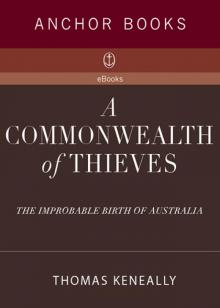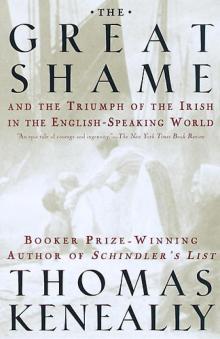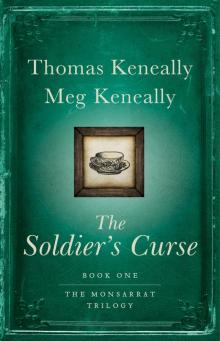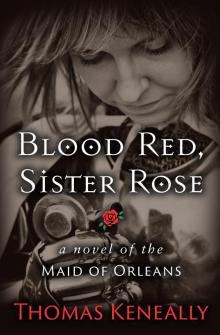- Home
- Thomas Keneally
Eureka to the Diggers Page 2
Eureka to the Diggers Read online
Page 2
There was a pattern from the start to issue tickets so that convicts could work for private employers, and the system was more successful than assignment had been in the east, in part because there were no women convicts transported to Western Australia. A Visiting Magistrates Board was established in 1850 to hear any complaints from either side of the contract. By the 1860s the convicts were building prisons at Perth and Fremantle, a new Government House, the Pensioner Barracks at Fremantle and the Perth Town Hall. Ships running between the east and Western Australia preferred the southern town of Albany as a port, but the road between the south coast and Perth remained primitive. Further roads closer in, however, were built by convict labour. Around York to the east of Perth and southwards towards Bunbury the new thoroughfares were hacked out by convicts amongst the huge shafts of native hardwood. The York pastoralist, landowner and merchant John Henry Monger would employ in all sixty-three ticket-of-leave men up to 1871. He was the largest exporter of sandalwood and so an important generator of capital for the under-capitalised west. Monger was a relatively rare native Western Australian, having been born in the Swan River colony in the misery days of 1831.
Western Australia had trouble getting all those it wanted. The number of statutory transportation sentences had diminished since the high days of eastern convictism. Only 300 British were so sentenced in 1860 and another 300 the following year. The Western Australian administration wanted 1000 a year and could not get them. Later in the decade some 600 a year would be sentenced—in large part due to republican offences in Ireland.
J.S. Hampton, who had been a feared controller-general of convicts in Van Diemen’s Land, came to Western Australia as governor in 1862, and in 1866 scandalously appointed his son Comptroller-General of Convicts in Western Australia, a lucrative post. The son’s severity was not far removed from the harsh conditions then being promoted at British prisons such as Pentonville. His thinking was influenced by an 1863 British Committee on Prison Discipline, which recommended that there should be a far more severe experience of punishment than that which transportees underwent. Transportation was no good for punishment, since Western Australian property owners wanted as many of the convicts working out of prison as possible. Young Hampton managed at least to abolish the Board of Visiting Magistrates in March 1867. Convicts no longer had any right of complaint. If they were guilty of misdemeanours they found themselves on bread-and-water diets in darkened cells in grim Fremantle gaol, backed up by flogging and banishment to chain gangs as distinct from mere work gangs. Attempts at escape tripled under Hampton junior.
But a new comptroller named Fauntleroy arrived from England in that year, and Hampton senior left office in 1868. Fauntleroy at once established a more humane, though still severe, regime and reduced the number of chain gangs. The British government was about to announce that transportation would end, and the last ship, the Hougoumont, arrived in January 1868 with convicts and an especially recognised and quartered group of Irish political prisoners, or Fenians. They were young men, self-taught, often middle class, who had observed the Famine in their childhoods and believed that Ireland must be freed from the Crown to be run equitably. They were also physical force men, who drilled, however ineffectually, in the hills outside Irish cities—and some were British soldiers who rebelled from within the ranks.
Throughout the history of convictism, except perhaps for some gentlemen prisoners after the Irish uprising of 1798, there had not been any accommodation of the idea of separating the politicals from the ‘common criminals’ as on the Hougoumont. The civilian Fenians aboard had access to paper and books and produced a handwritten newspaper edited by a young Fenian named Cashman. One of their leaders was a young man named John Kenealy, their spokesman when Prime Minister Gladstone pardoned four dozen of them in 1869. Kenealy was a young man who in time would repent of physical force but who would nonetheless invest in a Yankee whaling ship, the Catalpa, to rescue the last of the unpardoned life-sentenced Fenian soldiers on Easter Monday in 1876.
The transportation of these young men caused a great deal of anxiety amongst the Western Australian establishment, and a body of citizens sent a delegation to Earl Grey begging him not to send the Fenians. The concern in Perth was characterised by the Crown Solicitor, George Leake, who warned citizens that America too was full of Fenians and that it would take only one American Fenian vessel ‘merely armed with one long 18 pounder to lay Fremantle in ashes in a few hours’. The commodore of the British Naval Station in Sydney, Commodore Lambert, told Governor Hampton that to allay the fears of citizens he would send him HMS Brisk, a corvette of sixteen guns. Two companies of the 14th Regiment would also be temporarily brought from Tasmania.
A large number of these Fenians, when landed, worked in road and timber gangs. One convict, the Irish political prisoner John Boyle O’Reilly, a poet whose reputation would become international, would write of the country he worked in on a road gang:
Here the aisle
Moonlit and deep of reaching Gothic arms,
Realmed for towering gums, mahogany and palm,
And odourless jam, and sandal;
There the growth
Of arm-long velvet leaves grown hoar in calm—
In calm unbroken since their luscious youth.
He also called Western Australia ‘the Cinderella of the South’. A soldier Fenian, he was to serve a life sentence, but escaped on a Yankee whaler in 1869 and became a noted Bostonian newspaper editor and literary figure, once reading his verse in a three-hander literary session with Mark Twain and Walt Whitman. Some of his verse concerned the penal station for Aborigines on Rottnest Island. He would also write a highly popular novel named Moondyne concerning the convict Joseph Bolitho Johns, or Moondyne Joe, who was probably a better escapologist than bushranger.
Many of the civilian Fenians were pardoned by Prime Minister Gladstone in 1869 as a gesture towards Ireland, and most of them settled in the United States, though those who fell in love with Australian Irish girls on their way through Sydney—such as John Feehan, who married a dairy farmer’s daughter from Gerringong, and John Flood, who would become for many decades the newspaper editor and owner in Gympie—stayed in Australia. Some of the civilian Fenians whose names were inexplicably not on Gladstone’s list had to serve out their terms.
Most ex-convicts of either criminal or political origins remained labourers or became small farmers after their release but there were the normal convict success stories. One was that of Daniel Connor, a labourer’s son from County Kerry transported for sheep stealing. On his release he peddled goods out of a backpack he carried along the country roads around Perth and Fremantle. He began to speculate in livestock and bought land at Guildford, an area in which he had laboured as a convict, and married an Irish servant girl from his home county. In Toodyay he acquired property, a flour mill and hotel, and began to advance money under mortgage to other farms. He became a stern forecloser when drought or the reluctance of banks struck those he had lent to. He also ran illegal gambling in Toodyay from his hotel. His son-in-law, Timothy Quinlan, who managed his father-in-law’s Shamrock Hotel in Perth, would become a member of the Legislative Assembly. Two of his sons studied medicine at Trinity College Dublin and returned to Perth to practise.
DESOLATE IN THE EXTREME
It was in this era that Australians had it confirmed to them that at the country’s core lay no mothering wellsprings, no surging waters. Dryness was to be destiny. There could be no American-style rush to the centre, and no cities of the central plains. In 1862 John McDouall Stuart, a small-statured Scot tormented by alcoholism and driven on by that ruthless Presbyterian deity who drove the Scots in their prodigious endeavours worldwide, reinforced in his journal on crossing the Australian continent the water poverty and relentless geography of Central Australia. ‘I have searched every place where I think there is a remote chance of finding water, but without success.’
He encountered for days the ‘same open plains, with forest beyond’, the forest being stunted eucalypt and mulga, ‘sheltering no stream’. The fact that he had, in the north-west coastal area, found the Daly River very promising country, and had had pleasant times while camped in Newcastle Waters, a freshwater lagoon south of the Roper River, echoed only in the minds of those with pastoral ambitions in the north. Newcastle Waters on its own was not enough to compensate for the general dryness at Australia’s Centre.
The message was that the interior of Australia would be hard on its children. The generation of the 1860s and 1870s was the one which had to accommodate itself to the idea of a desiccation lying at Australia’s core. No great spine of water favoured the continent as the Mississippi did the United States. There was no Ohio, no Missouri, no Cumberland, along whose banks Jeffersonian farmers might settle. The vicious country let the explorers down and then tried to kill them. The serpentine water ran underground, was richly envisaged by the original race, but denied the explorer a sight of it.
Combined with the idea of blistering, stony emptiness was the idea that the explorer must suffer inordinately, and indeed, to enter the pantheon, should perish or disappear. Stuart, in many ways a paragon of Australian exploration, evaded death in the Centre only by his skills of organisation and his wisdom, but is not honoured as are the bumbling Burke and Wills. Stuart was a Scot born in 1815 and full of vigour when he first undertook his journeys in Australia. In 1844 he had travelled with Charles Sturt into the centre of the continent and saw the effects of scurvy on members of the expedition. There were other members of Homo sapiens sapiens out there who did not suffer from scurvy and had lived there for millennia, but they knew the country in a different way. In May 1858, with the help of William Finke—a South Australian merchant who would have the supposed oldest river on earth named in his honour—Stuart moved out of Adelaide with a companion, an Aboriginal tracker and provisions for four weeks to explore beyond Lake Torrens and Lake Gardiner and to look for grazing land. He got as far as Coober Pedy before turning south and then west.
In 1859, he went out again, financed by Finke and a colleague, James Chambers. Stuart always travelled swiftly, with small parties and without any Burke and Wills panoply or over-expenditure. He came back saying that he had found waterholes to provide the basis for a permanent route northwards. But his pace was frenetic, and he never allowed much time between expeditions. On 4 November that year he set out with his third expedition, and then was off again on 2 March 1860 with two men and thirteen horses. Most of their provisions were soon spoiled by floods and it was now that the party reached a channel temporarily full of water, which Stuart named the Finke.
Despite Stuart’s careful preparations and stress on travelling lightly and efficiently, the party began to suffer from scurvy and Stuart lost the sight in his right eye. They followed the Finke to the mountains that Stuart named after the Governor of South Australia, Sir Richard MacDonnell, the barren but beautiful range which stretches westward from the present site of Alice Springs. They headed north and on 22 April 1860 camped at a place that Stuart’s readings told him was the centre of the continent. Nearby he named Central Mount Sturt, later changed to Central Mount Stuart, and planted a flag as ‘a sign to the natives that the dawn of liberty, civilisation and Christianity were about to break on them’. After a futile attempt to go to the north-west, he found a creek which he named Tennant’s Creek and travelled on north 200 miles (320 kilometres) before he turned around, though not entirely because of an onslaught by the natives at Attack Creek, more than two-thirds of the way across the continent. Starting again on New Year’s Day 1860 he got 100 miles (160 kilometres) beyond it but met impenetrable scrub and himself began to die of dietary deficiency. Water was ever the problem—his horses on one occasion were 106 hours without it. Two months later the party dragged itself back into Chambers Creek Station in South Australia. The Centre had almost done for Stuart again.
At the end of 1860 the South Australian government voted £25 000 to equip a large expedition to be led by Stuart. This time he penetrated further but provisions ran out, clothes shredded, and he gave in. He got back to Adelaide on 23 September 1861. He received the 1861 gold medal of the Royal Geographical Society, but crossing the continent was still his furious ambition and he was quick to apply himself to it again and was ready to leave by the end of October. These quick turn-arounds after bouts of dietary disease and exhaustion seem ill-advised to a modern reader.
This time he took a botanist, Frederick Waterhouse, with him, and nineteen-year-old John Billiatt, future stalwart of Glenelg, Paraguayan adventurer, owner of a fencing school and enlightened student of the desert Aborigines. Early in that last expedition, Stuart was knocked down by a horse which then trampled his right hand, dislocating two joints of his first finger, tearing the flesh and injuring the bone. He rode back to town for treatment, evaded amputation, then took off in pursuit of his party.
Months later, he penetrated the scrub that had defeated him beyond Sturt’s Plain, and reached Daly Waters, named to honour South Australia’s new governor. Stuart thought that in the Roper River area he had encountered ‘the finest country I have seen in Australia’. He admired the Adelaide River too, though fire burned along it. The party rested at Daly Waters for two weeks, then on 24 July 1862 they forced their way through a tangled mass of vegetation and saw the Indian Ocean on the coast of Kakadu. ‘I advanced a few yards onto the beach, and was gratified and delighted to behold the water of the Indian Ocean . . . before the party with the horses knew anything of its proximity. It was not an idyllic beach but one of soft blue mud, typical of the tropic, the mud from which mangroves rose.’ The next day they fixed a Union Jack embroidered by Elizabeth Chambers in Adelaide to a tall bamboo stalk and had a modest celebration.
On the return journey, Stuart was ill with scurvy and became nearly blind, almost an exemplar of explorers’ failure to find in this zone landscapes softer on the eye. He could not eat much because the condition of his teeth prevented him from chewing. He declared that he was ‘very doubtful of my being able to stand the journey back to Adelaide; whatever may occur I must submit to the will of Divine Providence’.
As the party continued south, Stuart found it hard to endure the motion of the horse for twelve hours a day. On Tuesday 7 October he wrote, ‘What a miserable life mine is now! I get no rest night nor day from this terrible gnawing pain; the nights are too long, and the days are too long, and I am so weak that I am hardly able to move about the camp.’
By 16 October things were worse. ‘I am now nearly helpless; my legs are unable to support the weight of my body.’ He was taking potassium bicarbonate, which was recommended for his condition, but it was having little effect. By 27 October he was vomiting blood and mucus. The next day he lost the power of speech for a time. He was living on a little beef tea and some boiled flour. He could see nothing at night, and one of his party ‘informed me that my breath smelt the same as the atmosphere of the room in which a dead body had been kept for some days’.
He had been carried on a stretcher, slung between two horses. But now he found his health improved a little. At Polly Springs on the Finke River on the edge of the Simpson Desert he was able to walk two or three steps leaning on members of the party. But the strength was soon diminished by an attack of dysentery. At last, on 26 November and on a stretcher again, he was carried into Mount Margaret Station, the northernmost settled point in South Australia and the point at which all his expeditions, including this one, had begun. While still far from Adelaide, he wrote, ‘I am very doubtful of my being able to reach the settled districts. Should anything happen to me, I keep everything ready for the worst. My plan is finished, and my journal brought up every night, so that no doubt whatever can be thrown upon what I have done.’ The willpower required to keep his journal up to date must have been of an astounding scale.
The party arrived in Adelaide on 17 Decemb
er 1862. Stuart had assiduously observed the Sabbath throughout his treks and had lost not a single man. He was able to report that the country from the Roper River to the Adelaide River, and thence to the shores of the Gulf, was ‘well adapted’ for the settlement of a European population, ‘the climate being in every respect suitable, and the surrounding country of excellent quality and of great extent. Timber, stringy-bark, ironbark, gum, etc., with bamboo fifty to sixty feet high on the banks of the river, is abundant, and over convenient distances.’ These reports were not lost on enterprising pastoralists, though some of those who took him at his word would end by feeling as disappointed as, long before, Phillip had been at Cook’s report on Botany Bay. As Stuart’s party entered Adelaide, people lined the streets to cheer him and he was awarded £2000. But on that he was permitted only the interest to sustain a life now broken. He was white-haired, exhausted and nearly blind. He returned to Scotland to see his sister and his journals were published in 1864, but his health was ailing and he died of swelling of the brain—very likely cerebral meningitis—in June 1866. Some questioned whether he had reached the Indian Ocean in 1862 and others spoke of his alcoholism, but the tree on the Indian Ocean shore which he had marked with the initials JMDS was rediscovered in 1883 and photographed two years later.

 Confederates
Confederates Flying Hero Class
Flying Hero Class Gossip From the Forest
Gossip From the Forest Schindler's List
Schindler's List Bring Larks and Heroes
Bring Larks and Heroes Australians: Flappers to Vietnam
Australians: Flappers to Vietnam The People's Train
The People's Train Crimes of the Father
Crimes of the Father A Family Madness
A Family Madness A Commonwealth of Thieves
A Commonwealth of Thieves Ned Kelly and the City of Bees
Ned Kelly and the City of Bees A River Town
A River Town Bettany's Book
Bettany's Book Blood Red, Sister Rose: A Novel of the Maid of Orleans
Blood Red, Sister Rose: A Novel of the Maid of Orleans Victim of the Aurora
Victim of the Aurora American Scoundrel American Scoundrel American Scoundrel
American Scoundrel American Scoundrel American Scoundrel Three Cheers for the Paraclete
Three Cheers for the Paraclete Australians: Origins to Eureka: 1
Australians: Origins to Eureka: 1 The Power Game
The Power Game The Chant Of Jimmie Blacksmith
The Chant Of Jimmie Blacksmith The Daughters of Mars
The Daughters of Mars Searching for Schindler
Searching for Schindler The Great Shame: And the Triumph of the Irish in the English-Speaking World
The Great Shame: And the Triumph of the Irish in the English-Speaking World Abraham Lincoln
Abraham Lincoln The Widow and Her Hero
The Widow and Her Hero Eureka to the Diggers
Eureka to the Diggers Shame and the Captives
Shame and the Captives The Survivor
The Survivor Jacko: The Great Intruder
Jacko: The Great Intruder The Book of Science and Antiquities
The Book of Science and Antiquities Homebush Boy
Homebush Boy The Playmaker
The Playmaker To Asmara: A Novel of Africa
To Asmara: A Novel of Africa A Woman of the Inner Sea
A Woman of the Inner Sea The Tyrant's Novel
The Tyrant's Novel Australians
Australians Schindler's Ark
Schindler's Ark The Soldier's Curse
The Soldier's Curse Australians, Volume 3
Australians, Volume 3 Blood Red, Sister Rose
Blood Red, Sister Rose A Victim of the Aurora
A Victim of the Aurora The Unmourned
The Unmourned Australians, Volume 2
Australians, Volume 2 To Asmara
To Asmara